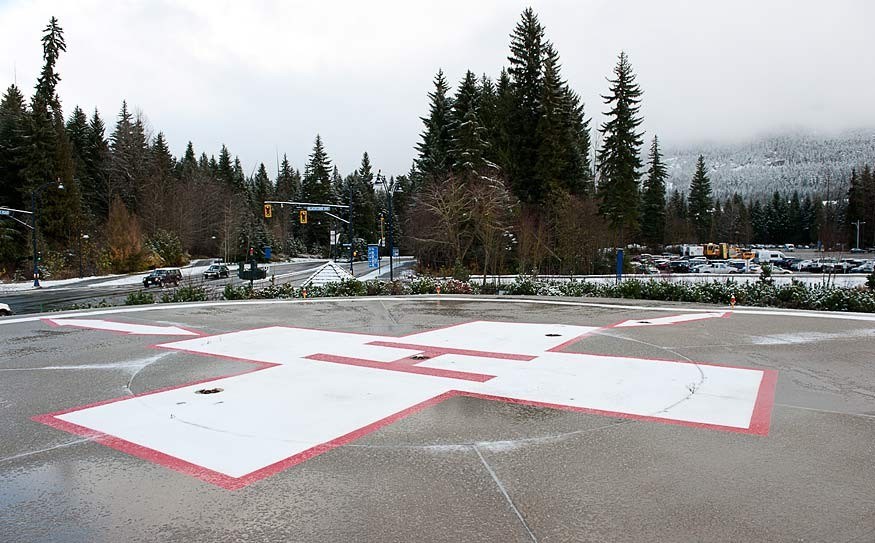Have you ever felt when reading a report that you are missing something?
Well I have to confess that I have felt that for these many months of Pique's on-going coverage of the upgrades to the certified helipad at the Whistler Health Care Centre.
Residents of Whistler, perhaps more than most, know that all kinds of things can go wrong during "renovations." So a heavy sigh and a shrug of the shoulders might be the expected response when we hear from Vancouver Coastal Health, the designated operator of the helipad, about the woes of not having the right parts, and so on, as it continues with the upgrades.
I have no doubt that in many ways VCH is as frustrated by this project as we are.
But this winding tale of bureaucracy has been going on for years now, and trying to find the "black box" of this crash and burn tale is vexing, let me tell you.
A little background is needed here: The helipad opened in the mid 1990s and was used as needed to get the most seriously injured off the mountain, out of the back country, or from car crashes and other medical emergencies to the care they needed in a timely fashion.
At the time it was mostly used by helicopters with only one engine, definitely not allowed any more due to all the environmental obstacles in the way, including people.
There can be little argument that coming into land beside two busy roads, Blackcomb Way and Lorimer Road, has risks —as does flying over town centre or the residences nearby to get there. But those are the facts of the location and they can't be changed.
"Transport Canada has received several safety concerns regarding people and vehicle traffic underneath the approach and departure paths of the heliport from pilots using the facility. This can be very dangerous for both helicopters and those on the ground," said a Transport Canada spokesperson in an email.
It is clear through information from Transport Canada that the approach into Whistler's helipad, as well as some other environmental hazard issues, did not meet the organization's safety standards and this was shared with Vancouver Coastal Health over the years.
Then in late 2009 Transport Canada gave VCH until November 2011 to meet its safety regulations.
Asked if this was result of inspections in preparation for the February 2010 Olympic Games received no clear response from TC. Surprise.
Asking if this ultimatum was linked to any deadly helicopter crashes fared no better in terms of a response.
Interesting to note, just in passing, that Transport Canada released its report into a deadly 2008 crash of a single engine helicopter in Cranbrook, which killed four people, one of them a pedestrian, in early 2009. Transport Canada could not determine the cause of the crash but CBC reported at the time: "Chief investigator Damien Lawson blamed widespread industry confusion over regulations governing low-level flights, and said that if the pilot had applied for permission it would not have been granted.
"We do find that there is considerable misunderstanding, misinterpretations in the industry about these regulations, because they are somewhat complex," said Lawson.
As result of the investigation, Transport Canada issued clearer guidelines on the regulations controlling low-level flights. Yesterday, April 4, Canada's Auditor General slammed TC for not addressing aviation issues in a timely manner.
I always loved playing connect-the-dot games with my kids when they were younger.
Back to the timeline: In order for Vancouver Coastal Health to do the work needed to meet Transport Canada's rules to allow helicopters with multiple engines to land — single engine helis are totally off the table now — trees had to come down, people had to be trained to stop traffic, the landing pad needed upgrades and light standards had to be lowered. Though VCH knew of TC's demands in late 2009 it didn't come before council to ask for permission to make the changes needed until October 2010. You can imagine how that went over.
Mayor Ken Melamed described it as "shameful" at the time.
In December 2010 the trees were cut and a plan was in place to have the RCMP, Whistler Blackcomb staff and staff of the health care centre manage traffic and the two-engine helis were allowed to continue landing on a temporary basis by Transport Canada.
Is anyone else shaking their heads as they read that plan? VCH said at the time that it would hire a consultant to come up with a long-term plan to manage closing the intersections during landings. That was to be done by April 2010.
Then in April 2011 the helipad was closed completely for further upgrades to the landing pad, and though it was understood the closure would be short, it has in fact now been out of service for a year. All flights are diverted to the municipal heliport north of Whistler.
On top of losing the helipad for all these months we have learned that the $500,000 upgrade is actually closer to $1million. And a $100,000 a year position must now be created to manage the new and improved helipad when it does finally open.
There is no doubt that Whistler's heliport problems came at a time when health authorities across the province were being restructured by government order, but looking back that still does not explain the fumbling that seems to have followed this file.
We all want safety to be a top priority, and that is precisely why it's time to get the stakeholders at the table to hammer out the future of the helipad once and for all.
With up to seven life-saving heli flights a week needing to land at the health care centre this simply can't wait any longer.




